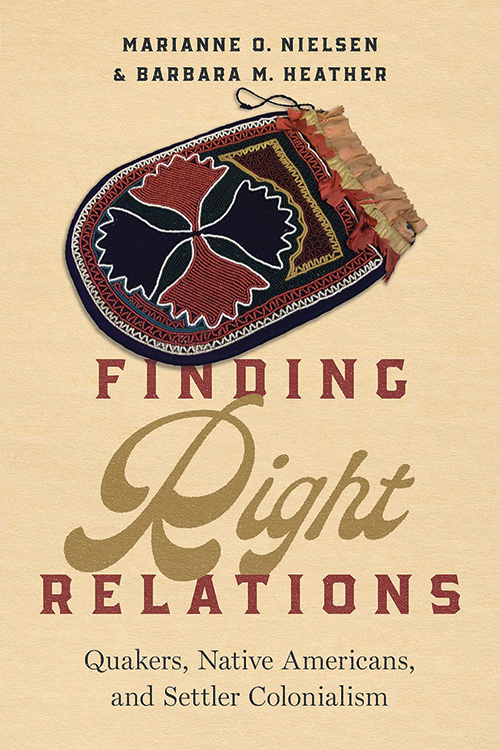
Finding Right Relations: Quakers, Native Americans, and Settler Colonialism
Reviewed by David Etheridge
September 1, 2023
By Marianne O. Nielsen and Barbara M. Heather. The University of Arizona Press, 2022. 224 pages. $45/hardcover or eBook; $24.95/paperback.
Finding Right Relations: Quakers, Native Americans, and Settler Colonialism is a careful examination of how the Quaker testimonies fared among Friends in colonial Pennsylvania in the face of the anti-Native settler, colonialist attitudes of their neighbors and the often-unexamined view of many of those Friends that European cultures were superior to the cultures of Indigenous people. Friends today must still wrestle with those same testimonies in the face of the culture that surrounds us and the biases we have absorbed from that culture. Consequently, this account of late seventeenth- and eighteenth-century Pennsylvania is a cautionary tale for us today.
The peace testimony led Quakers to oppose reliance on war to resolve disputes with their Native neighbors. The integrity testimony inspired the creation of a regulatory body to guard against fraudulent trading practices. The equality testimony required Quakers to treat Natives and non-Natives equally.
The opposition of Quaker colonial officials to the use of military force was deeply unpopular with other colonists who felt threatened by Native Lenape. Quaker efforts to regulate against fraudulent colonial practices in trading with the Lenape were opposed by many colonists and “[went] defunct” by the mid-1660s. Those colonists regarded Lenape as “other” and did not treat Indigenous people and their fellow colonists equally. Settler colonialism relied on military force to intimidate those colonized. Using force to impose the rules of the colonizers on the colonized was justified by an ideology that presumed the cultural and religious superiority of the colonizers.
The authors document how the Quakers over time abandoned their testimonies in the face of opposition from other settlers, but they also document how the Quakers themselves held biases that undermined their adherence to Quaker testimonies. At the outset, the Quakers’ willingness to accept a charter from the king of England authorizing them to govern land on another continent committed them to the idea that their relationship to the people they found on that land would be one of inequality. They regarded Indigenous people as essentially different from the European settlers and in need of an education to learn European culture and practices. The Quaker willingness to enslave people of African descent suggests that the testimony of equality was regarded as having limited application to People of Color.
The authors report the outcome of this combination of external pressure on the Quakers and their own compromised commitment to their testimonies:
By 1755 the province was on the edge of war. Those Friends who had betrayed their Truth, and the many settlers who never subscribed to them, had between them caused intense harm to Indigenous Peoples, betraying the hospitality of the First Peoples, denigrating, cheating, denying their humanity, and, in some cases, murdering to obtain the lands they wanted.
The authors expand their scope both geographically and chronologically to describe Quaker involvement with schools for Indigenous children in Canada and the United States in the eighteenth and the nineteenth centuries. Quaker educational efforts tried to supplant Indigenous culture with European culture. Shortly after the Civil War, Quakers successfully lobbied President Grant to entrust the administration of schools for Indigenous children to various Christian sects, including Quakers. Boarding schools were established that effectively reduced parental influence on Indigenous children. The result, the authors explain, was the near destruction of Indigenous culture and long-term adverse consequences for the children.
Despite the disastrous results of the historical failure of Quaker testimonies to govern relations between Quakers and Natives, the authors find inspiration in those testimonies for a way forward. The testimony of equality led John Woolman in the eighteenth century to visit Indigenous people with the expectation that he was as likely to receive instruction from them as they were to learn from what he had to offer. The authors practice that approach when they do a comparison of peacemaking practices among “Old Lenape,” “Old Quaker,” “Modern Navajo,” and “Modern Quaker” communities.
In the final chapter, the authors describe twenty-first-century efforts by Quakers in the United States and Canada to overcome their biases and be faithful to the testimonies as they work as advocates in alliance with Native peoples to repair the harm Quakers have caused.
David Etheridge is a member of Friends Meeting of Washington (D.C.) and clerk of the Baltimore Yearly Meeting Working Group on Racism. He previously worked for over 20 years as an attorney in the Indian Affairs Division of the Solicitor’s Office of the U.S. Department of the Interior.



Comments on Friendsjournal.org may be used in the Forum of the print magazine and may be edited for length and clarity.